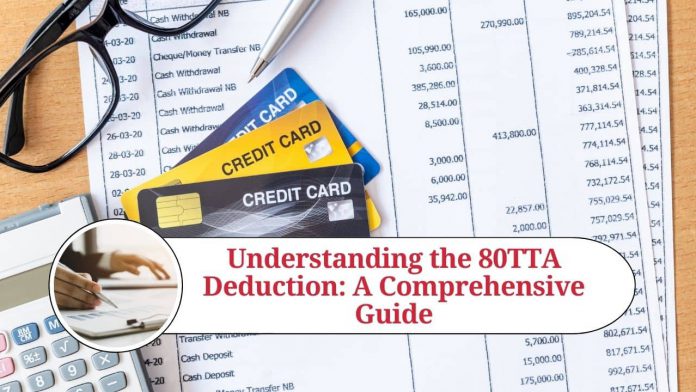Introduction As a taxpayer in India, you have the opportunity to take advantage of various deductions to reduce your taxable income. One such deduction is the 80TTA deduction, which is aimed at promoting saving habits among individuals. In this article, we will take a deep dive into the 80TTA deduction and help you understand how you can benefit from it.
What is 80TTA Deduction?
Section 80TTA of the Income Tax Act, 1961 allows individuals to claim a deduction of up to Rs.10,000 on the interest earned from savings bank accounts. This deduction is applicable to individuals and Hindu Undivided Families (HUFs) but not to trusts, partnerships or companies.
Eligibility Criteria for 80TTA Deduction
To claim the 80TTA deduction, an individual or HUF must satisfy the following eligibility criteria:
The deduction is applicable only to interest earned from savings bank accounts.
The maximum deduction that can be claimed under this section is Rs.10,000 per financial year.
The individual or HUF must be a resident of India.
The deduction is not available for interest earned from fixed deposits or recurring deposits.
Calculating 80TTA Deduction
To calculate the 80TTA deduction, you need to determine the total interest earned from your savings bank account(s) in a financial year. The maximum deduction that can be claimed under this section is Rs.10,000. Therefore, if the interest earned is less than Rs.10,000, the entire amount can be claimed as a deduction. However, if the interest earned is more than Rs.10,000, the deduction can only be claimed up to Rs.10,000.
Example: Suppose you have earned an interest of Rs.12,000 from your savings bank account in a financial year. In this case, you can claim a deduction of only Rs.10,000 under the 80TTA section.
Documents Required for 80TTA Deduction
To claim the 80TTA deduction, you need to provide the following documents:
Bank statement showing the interest earned from the savings account.
PAN card details.
Filing for 80TTA Deduction To claim the 80TTA deduction, you need to file your income tax return (ITR) and mention the deduction amount under the ’80TTA’ section. You can file your ITR online on the Income Tax Department’s e-filing portal or by consulting a tax expert.
Limitations of 80TTA Deduction
While the 80TTA deduction is an attractive proposition for individuals and HUFs, there are certain limitations to it:
The deduction is not available for interest earned from fixed deposits or recurring deposits.
The deduction is only applicable to interest earned from savings bank accounts, and not from current accounts or other deposit accounts.
The maximum deduction that can be claimed under this section is Rs.10,000 per financial year.
Conclusion
The 80TTA deduction is a great way for individuals and HUFs to reduce their taxable income and save money. By taking advantage of this deduction, you can lower your tax liability and increase your savings. However, it is important to note that the deduction is subject to certain limitations, and you must satisfy the eligibility criteria to claim it. We hope this guide has helped you understand the 80TTA deduction and its benefits.
Read more useful content:
- How to Save Tax on Salary
- Guide to Understanding Direct Taxes in India
- Filing Income Tax Returns
- GST E-invoice
Frequently Asked Questions
Q. Who is eligible for the 80TTA deduction?
Answer: The 80TTA deduction is applicable to individuals and Hindu Undivided Families (HUFs) but not to trusts, partnerships or companies.
Q. What is the maximum deduction that can be claimed under the 80TTA section?
Answer: The maximum deduction that can be claimed under the 80TTA section is Rs.10,000 per financial year.
Q. What type of interest is eligible for the 80TTA deduction?
Answer: The 80TTA deduction is applicable only to interest earned from savings bank accounts.
Q. Is the 80TTA deduction applicable to non-residents?
Answer: No, the 80TTA deduction is applicable only to residents of India.
Q. Can the 80TTA deduction be claimed for interest earned from fixed deposits or recurring deposits?
Answer: No, the 80TTA deduction is not available for interest earned from fixed deposits or recurring deposits.
Q. What documents are required to claim the 80TTA deduction?
Answer: To claim the 80TTA deduction, you need to provide a bank statement showing the interest earned from the savings account and your PAN card details.
Q. How is the 80TTA deduction calculated?
Answer: To calculate the 80TTA deduction, you need to determine the total interest earned from your savings bank account(s) in a financial year. The maximum deduction that can be claimed under this section is Rs.10,000.
Q. Can the 80TTA deduction be claimed for interest earned from current accounts?
Answer: No, the 80TTA deduction is only applicable to interest earned from savings bank accounts and not from current accounts or other deposit accounts.
Q. What are the limitations of the 80TTA deduction?
Answer: The limitations of the 80TTA deduction are that it is not available for interest earned from fixed deposits or recurring deposits, it is only applicable to interest earned from savings bank accounts, and the maximum deduction that can be claimed is Rs.10,000 per financial year.
Q. How can I claim the 80TTA deduction?
Answer: To claim the 80TTA deduction, you need to file your income tax return (ITR) and mention the deduction amount under the ’80TTA’ section. You can file your ITR online on the Income Tax Department’s e-filing portal or by consulting a tax expert.




















